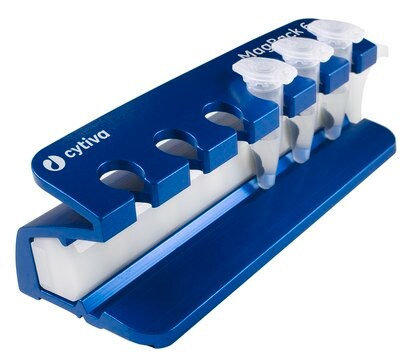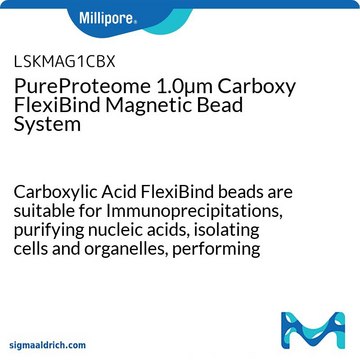GE65152105050250
SpeedBeads magnetic carboxylate modified particles
Cytiva 65152105050250, 0.70-1.10 μm avg. part. size, suspension (5% Solids)
Synonyme(s) :
SpeedBeads
Se connecterpour consulter vos tarifs contractuels et ceux de votre entreprise/organisme
About This Item
Code UNSPSC :
12352202
Nomenclature NACRES :
NA.56
Produits recommandés
ligand
(carboxylate modified particles)
Forme
suspension (5% Solids)
Conditionnement
pkg of 15 mL
Fabricant/nom de marque
Cytiva 65152105050250
Concentration
50 mg/mL
Taille moy. des particules
0.70-1.10 μm
Conditions d'expédition
wet ice
Température de stockage
2-8°C
Description générale
Sera-Mag™ SpeedBeads and Sera-Mag™ Carboxylate-Modified Magnetic Particles combine a fast magnetic response time and high binding capacity with a large surface area, high sensitivity, stability, physical integrity, and fast reaction kinetics. Covalent coupling of biomolecules such as proteins and nucleic acids to carboxyl groups on the surface is easily accomplished using our standard coupling technology. The core of the particle is made by a free radical emulsion polymerization of styrene and acid monomer. One (Sera-Mag™) or two (Sera-Mag™ SpeedBeads) layers of magnetite are then coated onto this core, while the surface is modified to minimize non-specific binding of proteins.
Application
Sera-Mag™ SpeedBeads and Sera-Mag™ Carboxylate-Modified Magnetic Particles typical application uses include sample preparation, proteomics, nucleic acid isolation, and immunoassay applications.
Caractéristiques et avantages
Sera-Mag™ SpeedBeads and Sera-Mag™ Carboxylate-Modified Magnetic Particles allow convenient covalent coupling of target molecules.
- Carboxylic groups on the surface permit easy covalent coupling to biomolecules of interest using convenient carbodiimide chemistry.
- Different levels of hydrophobicity/hydrophilicity available.
- Available in Sera-Mag™ SpeedBeads and original Sera-Mag™ versions.
- Excellent sensitivity and low nonspecific binding for greater accuracy.
- Fast Magnetic Response Times and Stable Physical Integrity
Remarque sur l'analyse
To view the Certificate of Analysis for this product, please visit www.cytiva.com.
Informations légales
Sera-Mag is a trademark of Cytiva
Code de la classe de stockage
12 - Non Combustible Liquids
Classe de danger pour l'eau (WGK)
WGK 3
Point d'éclair (°F)
Not applicable
Point d'éclair (°C)
Not applicable
Certificats d'analyse (COA)
Recherchez un Certificats d'analyse (COA) en saisissant le numéro de lot du produit. Les numéros de lot figurent sur l'étiquette du produit après les mots "Lot" ou "Batch".
Déjà en possession de ce produit ?
Retrouvez la documentation relative aux produits que vous avez récemment achetés dans la Bibliothèque de documents.
Les clients ont également consulté
Structural variation detection by proximity ligation from FFPE tumor tissue.
Troll C, et al.
bioRxiv, 266023-266023 (2018)
Design and specificity of long ssDNA donors for CRISPR-based knock-in.
Li H, et al.
bioRxiv, 178905-178905 null
Jan Leipert et al.
Lab on a chip, 19(20), 3490-3498 (2019-09-19)
While LC-MS-based proteomics with high nanograms to micrograms of total protein has become routine, the analysis of samples derived from low cell numbers is challenged by factors such as sample losses, or difficulties encountered with the manual manipulation of small
G Stefano Brigidi et al.
Cell, 179(2), 373-391 (2019-10-05)
Cells regulate gene expression in response to salient external stimuli. In neurons, depolarization leads to the expression of inducible transcription factors (ITFs) that direct subsequent gene regulation. Depolarization encodes both a neuron's action potential (AP) output and synaptic inputs, via
Suman Rao et al.
Cell chemical biology, 26(6), 818-829 (2019-04-16)
Covalent kinase inhibitors, which typically target cysteine residues, represent an important class of clinically relevant compounds. Approximately 215 kinases are known to have potentially targetable cysteines distributed across 18 spatially distinct locations proximal to the ATP-binding pocket. However, only 40
Notre équipe de scientifiques dispose d'une expérience dans tous les secteurs de la recherche, notamment en sciences de la vie, science des matériaux, synthèse chimique, chromatographie, analyse et dans de nombreux autres domaines..
Contacter notre Service technique






